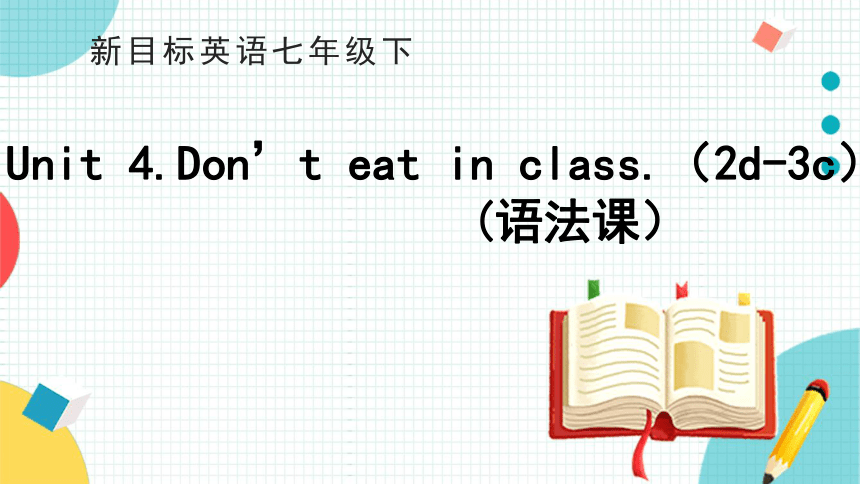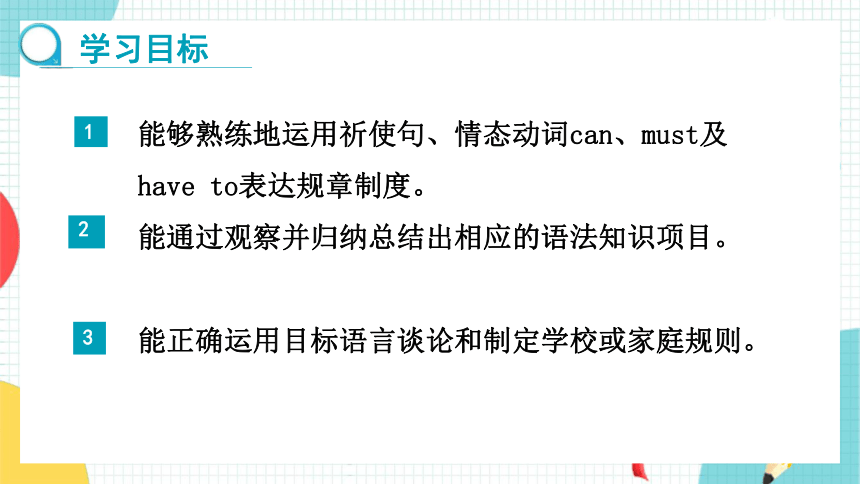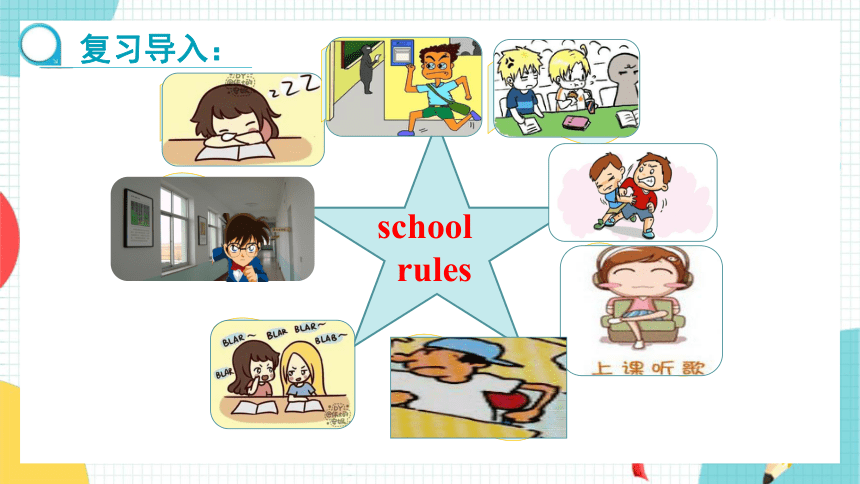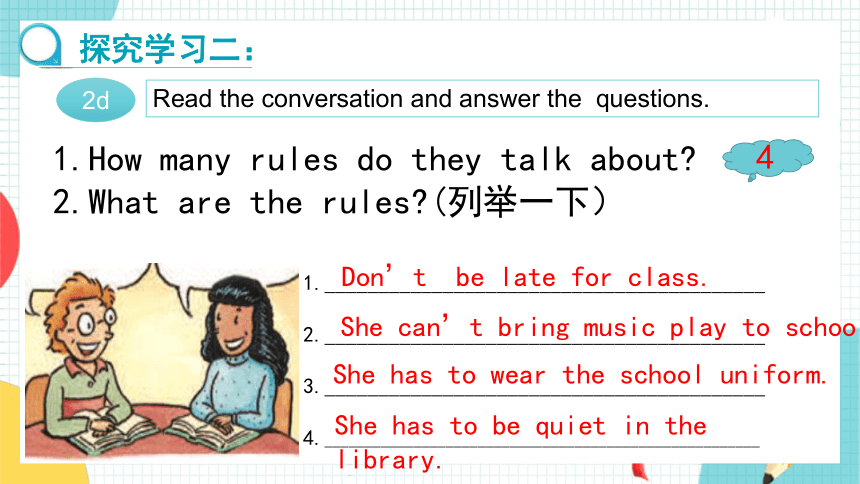Unit 4 Don't eat in class. Section A 2d-3c 语法课 课件
文档属性
| 名称 | Unit 4 Don't eat in class. Section A 2d-3c 语法课 课件 |  | |
| 格式 | pptx | ||
| 文件大小 | 5.4MB | ||
| 资源类型 | 教案 | ||
| 版本资源 | 人教新目标(Go for it)版 | ||
| 科目 | 英语 | ||
| 更新时间 | 2022-03-21 15:56:04 | ||
图片预览







文档简介
(共18张PPT)
新目标英语七年级下
Unit 4.Don’t eat in class.(2d-3c)
(语法课)
学习目标
能够熟练地运用祈使句、情态动词can、must及have to表达规章制度。
能通过观察并归纳总结出相应的语法知识项目。
能正确运用目标语言谈论和制定学校或家庭规则。
1
2
3
复习导入:
school rules
Don’t sleep
in class.
Don’t arrive
late for class
Don’t eat
in class.
Don’t run
in the hallways.
Don’t fight.
Don’t listen
to music in
the classroom.
Don’t wear hats
in class.
Don’t talk
in class.
1.在学校_________ 2.我的第一天________
3.许多规则_________4.一些规则_________
5.迟到_____________6.不得不___________
7.把…带到某地_______ 8.准时________
9.校服_________ 10.保持安静 _________
11.在图书馆_______12.图书馆规则_______
in the school
my first day
a lot of rules
some of the rules
be late for class
on time
bring sb. to +地点
have to/has to
school uniform
be quiet
in the library
library rules
预习展示
2d
Read the conversation and complete the phrases.
There are a lot of rules in Alice’s school .
True or false
探究学习一:
2d
Read the conversation and make a choice.
文字内容
文字内容
文字内容
文字内容
1.How many rules do they talk about
2.What are the rules (列举一下)
Don’t be late for class.
She can’t bring music play to school.
She has to wear the school uniform.
She has to be quiet in the library.
探究学习二:
1._________________________________________
2._________________________________________
3._________________________________________
4.______________________________________________________
2d
Read the conversation and answer the questions.
4
输入标题
知识积累:
There be 句型之详解
1.意思是“某处有某物”。
2.there be句型中的be应和其后出现的主语在数上一致,即就近原则。
e.g. 1.There is an apple on the table.
2.There are some apples in the bowl.
3.There are five books, two pens and a ruler in the school bag.
4.There is a ruler, two pens and five books in the school bag.
既学既练:
1.There _____ a teacher and many students in our classroom.
2.There _____ two boys and a girl under the tree.
3.There _____ some apples in the tree.
4.There _____ a woman near the house.
is
are
are
is
语法聚焦
Don’t run in the hallways. Don’t fight.
What are the rules We must be on time for class.
Can we eat in the classroom No, we can’t, but we can eat in the dining hall.
Can we wear a hat in class Yes, we can./No, we can’t.
Does he have to wear a uniform at school Yes, he does./No, he doesn’t.
What do you have to do We have to be quiet in the library.
Grammar Focus
1. 圈出情态动词,情态动词在用法上有什么共同点?
2. 祈使句的否定句怎么样构成的?肯定句呢?一般什么情况下使用祈使句?
3. can在本单元主要表示什么含义?它还可以表达什么意思?
4. have to在句法上与情态动词must的区别
学习概括一:
Have to /has to 与must的区别及用法
(1) have to 着重于客观的需要,含有客观强制性,意为不得不;
(5)must一般只表示现在,没有人称和数的变化。
I like English, I ________ do my homework .
I don’t like English,but I______ to finish my homework .
She __________ to finish her work today.
They _________ to get to the station before 5:00.
(3)must着重于主观上自己认为有义务,有必要,意为必须。
(4)have to可以用于不同的时态,有人称和数的变化。
(2) has to 是have to 的三单形式。
must
have to
has to
had to
1. 不要在楼道里跑。
______________________________
2. 不要打架。
____________________
3. 有什么规则?
______________________________
4. 我们必须按时上课.
_______________________________
课 堂 学 习
Don’t run in the hallways.
Don’t fight.
What are the rules
We must be on time for class.
课 堂 学 习
5. 我们可以在教室里吃东西吗?
_____________________________
6. 不能。但我们可以在餐厅里吃东西。
________________________________
________________________________
7. 我们可以在上课的时候带帽子吗?
_____________________________
Can we eat in the classroom
No, we can’t, but we can eat in the
dining hall.
Can we wear a hat in class
8. 他在学校里必须穿校服吗?
__________________________________
9. 是的,必须。/ 不,不必。
_______________________________
10. 你们必须做什么?
_______________________________
11. 在图书馆里我们必须保持安静。
_________________________________
课 堂 学 习
Does he have to wear a uniform at school
Yes, he does. / No, he doesn’t.
What do you have to do
We have to be quiet in the library.
3a
Write the rules for the school library.
Library Rules
1.___________
2.___________
3.___________
4.___________
Don’t talk.
Don’t eat.
Don’t listen to music.
Don’t take photos.
请你帮忙
Tips:
1.图示都是一些禁止类的祈使句。
2.应用don’t +动词原形的形式
课 堂 巩固
Be quiet (she/have to /in the library)
Q: Does she have to be quiet in the library
A: Yes, she does.
Use the words to make questions about the rules. Then write answers according to your school.
3a
方法指导
1. 根据例句,可知要求我们造一般疑问句并根据实际情况进行回答。
2. 先确定句子的主语。
3. 再确定用情态动词还是用助动词来构成疑问语序。
4. 根据实际情况做出肯定或否定回答,答语的主语要与问句保持一致。
课 堂 巩固
2. Eat (he/have to/in the dining hall)
Q: ________________________________
A: _____________
3. Listen to music (we/can/in the hallways)
Q: ________________________________
A: _____________
4. Wear a hat (we/can/in the classroom)
Q: _____________________________
A: ____________
Does he have to eat in the dining hall
Yes, he does.
Can we listen to music in the hallways
No, we can’t.
Can we wear a hat in the classroom
No, we can’t.
非常感谢观看
GENERAL BUSINESS
新目标英语七年级下
Unit 4.Don’t eat in class.(2d-3c)
(语法课)
学习目标
能够熟练地运用祈使句、情态动词can、must及have to表达规章制度。
能通过观察并归纳总结出相应的语法知识项目。
能正确运用目标语言谈论和制定学校或家庭规则。
1
2
3
复习导入:
school rules
Don’t sleep
in class.
Don’t arrive
late for class
Don’t eat
in class.
Don’t run
in the hallways.
Don’t fight.
Don’t listen
to music in
the classroom.
Don’t wear hats
in class.
Don’t talk
in class.
1.在学校_________ 2.我的第一天________
3.许多规则_________4.一些规则_________
5.迟到_____________6.不得不___________
7.把…带到某地_______ 8.准时________
9.校服_________ 10.保持安静 _________
11.在图书馆_______12.图书馆规则_______
in the school
my first day
a lot of rules
some of the rules
be late for class
on time
bring sb. to +地点
have to/has to
school uniform
be quiet
in the library
library rules
预习展示
2d
Read the conversation and complete the phrases.
There are a lot of rules in Alice’s school .
True or false
探究学习一:
2d
Read the conversation and make a choice.
文字内容
文字内容
文字内容
文字内容
1.How many rules do they talk about
2.What are the rules (列举一下)
Don’t be late for class.
She can’t bring music play to school.
She has to wear the school uniform.
She has to be quiet in the library.
探究学习二:
1._________________________________________
2._________________________________________
3._________________________________________
4.______________________________________________________
2d
Read the conversation and answer the questions.
4
输入标题
知识积累:
There be 句型之详解
1.意思是“某处有某物”。
2.there be句型中的be应和其后出现的主语在数上一致,即就近原则。
e.g. 1.There is an apple on the table.
2.There are some apples in the bowl.
3.There are five books, two pens and a ruler in the school bag.
4.There is a ruler, two pens and five books in the school bag.
既学既练:
1.There _____ a teacher and many students in our classroom.
2.There _____ two boys and a girl under the tree.
3.There _____ some apples in the tree.
4.There _____ a woman near the house.
is
are
are
is
语法聚焦
Don’t run in the hallways. Don’t fight.
What are the rules We must be on time for class.
Can we eat in the classroom No, we can’t, but we can eat in the dining hall.
Can we wear a hat in class Yes, we can./No, we can’t.
Does he have to wear a uniform at school Yes, he does./No, he doesn’t.
What do you have to do We have to be quiet in the library.
Grammar Focus
1. 圈出情态动词,情态动词在用法上有什么共同点?
2. 祈使句的否定句怎么样构成的?肯定句呢?一般什么情况下使用祈使句?
3. can在本单元主要表示什么含义?它还可以表达什么意思?
4. have to在句法上与情态动词must的区别
学习概括一:
Have to /has to 与must的区别及用法
(1) have to 着重于客观的需要,含有客观强制性,意为不得不;
(5)must一般只表示现在,没有人称和数的变化。
I like English, I ________ do my homework .
I don’t like English,but I______ to finish my homework .
She __________ to finish her work today.
They _________ to get to the station before 5:00.
(3)must着重于主观上自己认为有义务,有必要,意为必须。
(4)have to可以用于不同的时态,有人称和数的变化。
(2) has to 是have to 的三单形式。
must
have to
has to
had to
1. 不要在楼道里跑。
______________________________
2. 不要打架。
____________________
3. 有什么规则?
______________________________
4. 我们必须按时上课.
_______________________________
课 堂 学 习
Don’t run in the hallways.
Don’t fight.
What are the rules
We must be on time for class.
课 堂 学 习
5. 我们可以在教室里吃东西吗?
_____________________________
6. 不能。但我们可以在餐厅里吃东西。
________________________________
________________________________
7. 我们可以在上课的时候带帽子吗?
_____________________________
Can we eat in the classroom
No, we can’t, but we can eat in the
dining hall.
Can we wear a hat in class
8. 他在学校里必须穿校服吗?
__________________________________
9. 是的,必须。/ 不,不必。
_______________________________
10. 你们必须做什么?
_______________________________
11. 在图书馆里我们必须保持安静。
_________________________________
课 堂 学 习
Does he have to wear a uniform at school
Yes, he does. / No, he doesn’t.
What do you have to do
We have to be quiet in the library.
3a
Write the rules for the school library.
Library Rules
1.___________
2.___________
3.___________
4.___________
Don’t talk.
Don’t eat.
Don’t listen to music.
Don’t take photos.
请你帮忙
Tips:
1.图示都是一些禁止类的祈使句。
2.应用don’t +动词原形的形式
课 堂 巩固
Be quiet (she/have to /in the library)
Q: Does she have to be quiet in the library
A: Yes, she does.
Use the words to make questions about the rules. Then write answers according to your school.
3a
方法指导
1. 根据例句,可知要求我们造一般疑问句并根据实际情况进行回答。
2. 先确定句子的主语。
3. 再确定用情态动词还是用助动词来构成疑问语序。
4. 根据实际情况做出肯定或否定回答,答语的主语要与问句保持一致。
课 堂 巩固
2. Eat (he/have to/in the dining hall)
Q: ________________________________
A: _____________
3. Listen to music (we/can/in the hallways)
Q: ________________________________
A: _____________
4. Wear a hat (we/can/in the classroom)
Q: _____________________________
A: ____________
Does he have to eat in the dining hall
Yes, he does.
Can we listen to music in the hallways
No, we can’t.
Can we wear a hat in the classroom
No, we can’t.
非常感谢观看
GENERAL BUSINESS
同课章节目录
- Unit 1 Can you play the guitar?
- Section A
- Section B
- Unit 2 What time do you go to school?
- Section A
- Section B
- Unit 3 How do you get to school?
- Section A
- Section B
- Unit 4 Don't eat in class.
- Section A
- Section B
- Unit 5 Why do you like pandas?
- Section A
- Section B
- Unit 6 I'm watching TV.
- Section A
- Section B
- Review of Units 1-6
- Unit 7 It's raining!
- Section A
- Section B
- Unit 8 Is there a post office near here?
- Section A
- Section B
- Unit 9 What does he look like?
- Section A
- Section B
- Unit 10 I'd like some noodles.
- Section A
- Section B
- Unit 11 How was your school trip?
- Section A
- Section B
- Unit 12 What did you do last weekend?
- Section A
- Section B
